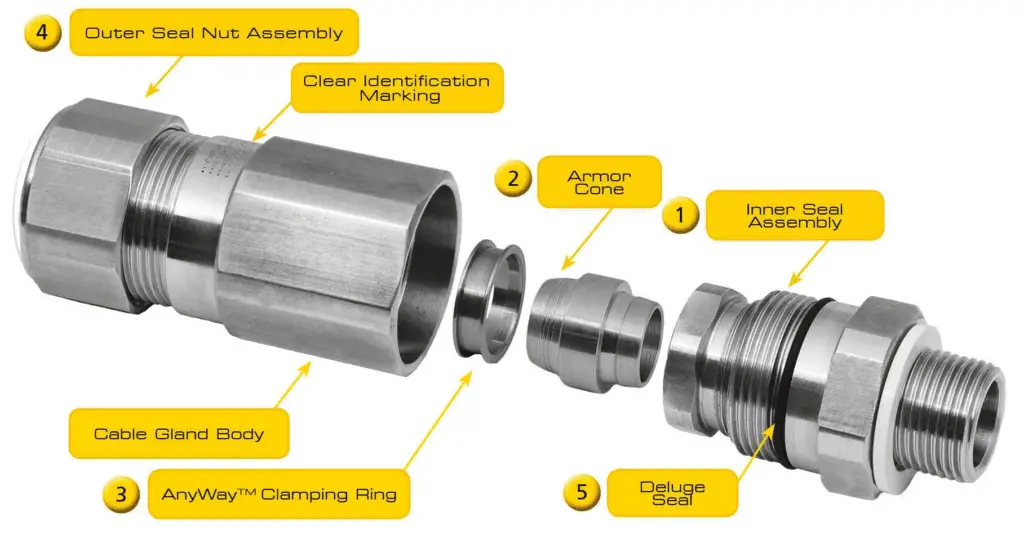Cable gland provides the sealing and retention of a cable after its entry into an enclosure. The primary function of the gland is to keep proper sealing and intactness of the cable inside the enclosure. The other secondary functions of the cable gland are earthing, bonding, insulation, cable guarding as well.
The gland is a mechanical item that is indispensable part of a cabling system. We can also call the cable gland as a cable connector because it has mechanical attachment with the cable. It also secures the mounting of cable to the equipment.
Cable glands have their wide applications in a number of industries. There are wide applications of the glands in the electrical, instrumentation, power, telecommunication, and automation systems.
The strain on the cable will stress the cable termination points if cable does not have gland. The stress on the end termination point may cause flashover. Thus, it is clear that without glanding, it is impossible to establish the reliability of the cabling system.
A cable gland provides strain relief to cable. Thus, during stress on the cable it keeps the intactness of the electrical connections. We can also use the cable glands for sealing cables passing through bulkheads or gland plates.
The cable glands are available in plastic, steel, brass or aluminum. The selection of cable gland depends on the types of application.
Why Aluminum Gland used for Single Core Cable?
For example, a single core cable must have aluminum or plastic gland. Why? The current in a single core cable generates a magnetic field. The magnetic field sets up circulating current if gland material is ferrous. Further, this circulating current causes heating of gland, and finally it cause insulation failure of cable. Therefore, gland made of non-magnetic materials like aluminum or plastic are suitable for single core cable.
Special Glands
We use a special type of gland to prevent the entry of flammable gas into equipment enclosures. Also, for preventing water entry into the electrical panel, the glands with synthetic rubber and elastomers seals are most suitable.
In terms of terminology we also call cable gland as a connector. Here, the connector means the cable mechanically attached to electrical panel. it is possible to disconnect the cable gland after disconnection of cable electrical connections.
Split Cable Glands
We can use the split cable glands for routing pre-terminated cables (cables with connectors).These cable glands have three main parts- two gland halves and a split sealing grommet. Two gland halves are screwed with a hexagonal locknut (like normal cable glands). Thus, it is possible to re-route the pre-assembled cables without removing the plugs.
It is also possible to route a large number of pre-terminated cables through one wall cut-out by split cable entry system. The split entry system has a hard frame and several sealing grommets.
There are three types of thread standard in cable glanding. These are;
- Panzergewinde (PG standard)
- Metric thread
- National Pipe Thread (inch system)
Cable Gland Parts

Above is a typical CMP double seal Cable Gland showing its parts.
Note : CMP is a cable gland manufacturer.
Inner Sealing(1)
In CMP cable gland unlike other cable gland type, the inner sealing ring has separation from the armour clamping. This feature eliminates the heedless over-tightening.
The traditional compression seals does not have direct control on their application, while the CMP inner sealing technique has a displacement seal that user can control independently during installation.
The Compensating Displacement Seal System (1) is very important feature of the CMP gland, and it takes its original displacement sealing ring concept to another level.
The unique compensator allows cable gland component to full tightening metal-to-metal. It also relieve the potential excess forces that can transfer to the cable bedding. Thus, this arrangement eliminate the possibility of cable damage and coldflow.
Coldflow in cables is the movement of the cable sheath under the compressive forces created by the displacement of seals in cable glands.
Secure Armour Termination(2) (3)
CMP armour clamping method comprises a unique termination solution that ensures a permanent crimping of the cable armour. Thus, it creates a low impedance connection that can not loose itself.
The clamping ring aids an easy ‘Right First Time’ installation. It secure armour clamping, and thus it contribute to enhanced levels of EMC performance as well as reliable earth continuity.
Outer Seal(4)
The Outer Seal Tightening Guide (OSTG) and Load Retention Sealing Ring (LRS) ensure formation of an IP/NEMA rated seal around the armoured cable to the correct degree. This type of solution is also available for unarmoured cable.
Proven Internally Enclosed Deluge Seal (5)
The integrated ‘O’ ring deluge seal (tested to DTS 01:91) prevents entry of moisture, and thus prevents corrosion of the cable armour. It ensures that moisture cannot track around the Cable Gland threads and into the armour termination body. An internally enclosed deluge seal the ‘O’ ring is protected from mechanical damage and harmful UV rays.
Related Articles:
- Cables-Types, Uses, Benefits, and Challenges
- Current Carrying Capacity of Aluminium Cable
- Difference between Intrinsic Safe and Non-intrinsic Safe Cables
- How to Test Cable With a Megger?
- Types of Underground Cables
- Difference between Power Cable and Control Cable
- Common materials used in instrumentation cable
- Difference between Flame Resistant and Flame Retardant Cables
- Cable Shielding – Purpose, Selection, Grounding
- Difference Between Copper & Aluminum Cables
- Selection Guidelines for Cable Glands
- Cable Power Loss Calculator, Formula, Calculation
- Electrical Cables Interview Questions & Answers
- Effects of Harmonics on Power Cables
- What is an Armoured Cable? Classification of Cables
- What is STP(Shielded Twisted Pair)?
- How to Avoid cable Heating at Screw Terminal?
- Types of Cable Trays: Purpose, Advantages, Disadvantages